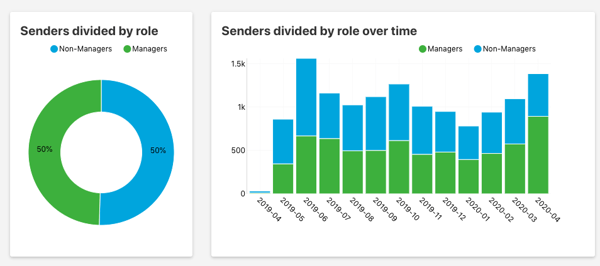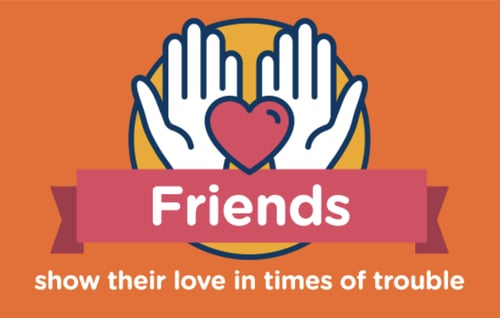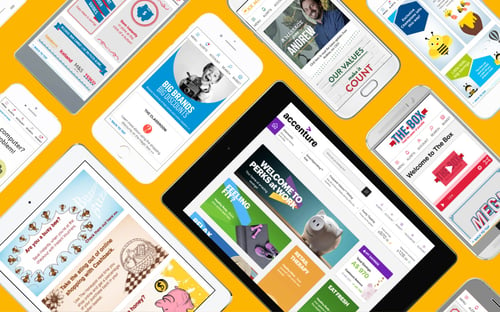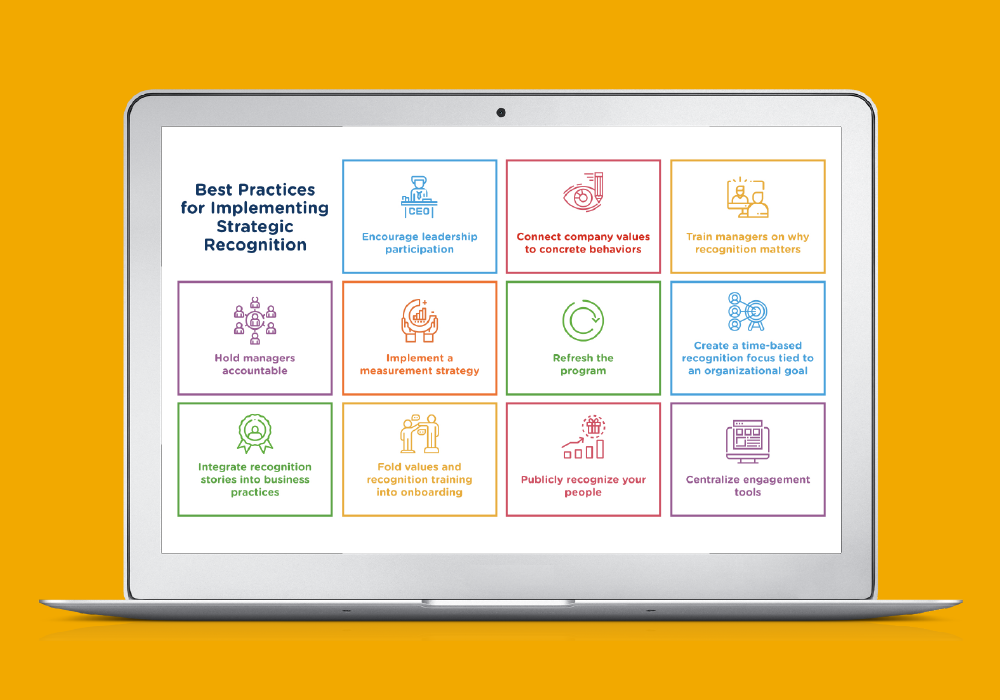8 min read
Although many organizations' priorities have shifted because of the COVID-19 pandemic, the need to engage your people hasn’t. The majority of employees today (about two-thirds, according to the latest research) are still disengaged from their workplace. These employees do not feel motivated or valued by their employers. Many feel invisible at work or simply lack recognition for the work they do.
Given the current climate, it’s more important than ever to make sure your people feel motivated and connected to your organization.
To foster employee engagement in your company, focus on strategic recognition to give employees the drive they need to keep moving forward during times of uncertainty, by recognizing the hard work they do (the very moment they do it!). Strategic employee recognition means showcasing any accomplishments that help improve the employee or customer experience, and further, that can be tied to your company’s values and goals.
How do you implement a strategic recognition plan that will work now and well into the future? According to our 2019 Bersin Report, any company (of any size) should prioritize the following employee recognition best practices when building a program for success.
1. Engage leaders in the program
Leaders are key drivers of company culture and strong examples of behavior in the workplace. When top-level executives support (and use!) strategic recognition, managers and employees are likely to participate, as well. According to our research, the CEOs who empower their teams through strategic recognition, and who hold managers accountable for using it, have the most successful employee recognition plans. Leadership during a crisis can look like:
| Setting an example and using employee recognition themselves |
| Holding others accountable for using the recognition program |
| Getting actively involved in measuring the program results |
| Actively working to improve team culture and recognition |
As one of our clients explained to us here, “Transforming your culture begins with your leaders – these are the people who are driving the engagement journey and keeping a pulse on your people.”
2. Connect your company values to concrete behaviors
Your company values define who you are, what is important to you and how you manage expectations on the day-to-day. As a result, your company values are also a strong employee engagement tool. They unify your workforce, bring teams together, and give your employees a singular, defined direction to go. This in turn provides much-needed stability.
When employees understand these values, and can observe them in action in the workplace (no matter where “work” might be right now), they are more likely to go above and beyond.
That said, you must make sure your employees can connect with your values and goals. Make them accessible, digestible, realistic and relatable. Companies that develop their values with input from employees, and that make values relevant to employees’ actual work, are more likely to see employees engaged and meeting/exceeding expectations.

3. Train managers on why recognition matters
When introducing an employee recognition program, you may receive push back from managers – like, “Why should I recognize people for doing their jobs?” This is especially true when many employees are working remotely, and might not be as visible as they would in an office setting so the day-to-day successes can easily get lost.
To prevent this, you must get managers on board from the very beginning, by educating them on the benefits of strategic recognition and the importance of shining a spotlight on the daily successes others in the business might not know about.
4. Hold managers accountable
Training managers is just one step in implementing a successful employee recognition program – ensuring they use it is even more critical. Employers can hold managers accountable by setting expectations and goals. For example, you may request that managers write at least one recognition per month. You can then track the usage of your recognition platform, to ensure they are keeping pace.

5. Implement a measurement strategy
In order to ensure your recognition program is successful, you must be able to measure impact and results. One way to do this is through employee surveys. Employee surveys are a valuable tool in tracking engagement and measuring progress towards your engagement (and company) goals.
Feedback is a gift and it's important to know what's working and what's not. By measuring employee satisfaction, you can work towards improving employee engagement. What's more, see how your employees' interactions are changing in the current environment by tracking usage of the platform over time. For example, are managers sending more recognition?

6. Refresh the recognition program
Employee recognition and reward programs must evolve alongside your company. Otherwise, employees may lose motivation over time. To keep the workplace actively engaged, refresh your recognition program by leveraging your employees’ feedback. If your company goals or values change, be sure your program is updated to be aligned with these.
Or if your working conditions have changed and now everyone is working remotely, implement some new eCards that reflect this and encourage your employees to use them. For instance, if a core focus in your business is safety for on-site employees, you might use new eCards or recognition tools to embed these behaviors into an employee's daily routines.
7. Create a time-based recognition focus tied to an organizational goal
When a company wants to create change or grow the business in a new direction, recognition can be a powerful driver of behavior. For example, a goal of “breaking down silos” can be translated into encouraging recognition for cross-functional communication and collaboration. Similarly, department goals such as “first call resolution” for a call center can be tied to a recognition focus.

8. Integrate recognition into business practices
Companies that carry recognition stories over to the business, so that they can be shared and heard, are likely to see powerful results. For example, some company leaders implement a “1-minute reminder” to open business meetings with a recognition story. This amplifies the recognition culture by not only motivating the employee being recognized, but also the other employees in the meeting who desire that level of recognition.
9. Fold values and recognition training into onboarding
Recognition can start on an employee’s first day of work. It’s key to show frontline workers appreciation as well as those who are working remotely. All new employees should be educated on how recognition works in your company, and what your company values and expectations are.
When these are introduced during the onboarding process, you set new hires up for success. They will benefit from hearing other recognition stories and observing examples of recognition within the company. Most of all, by understanding your company values, they will better understand the desired behaviors that are likely to be rewarded over time.

10. Publicly recognize your people to increase engagement
The original report discussed how to gamify the program with points and rewards. And while this remains a crucial aspect of an employee recognition program, we're expanding this to include making recognition public, especially important now as people work remotely. Everyone loves to feel appreciated and your employees are no exception.
While everyone is dispersed, working in different locations across the country – technology is the glue that’s keeping us together.
When we can communicate and recognize one another publicly for everyone in the business to see, other departments and teams are kept in the loop about big projects. By making employee recognition public during uncertain times, employees can feel more connected than ever before.

11. Centralize engagement tools
As with any technology you implement, centralization is key. You want to make it easy for your employees to adopt recognition practices, so it is important to give them a system that easy-to-use and log into. If they have to remember how to use the program every time, they are unlikely to use it at all, especially when your typical employee might be using several digital tools at once.
Choosing an employee recognition program that is completely customizable to your company’s needs can help your teams feel even more connected to the recognition program you decide to put in place.
Driving Employee Recognition Results
Employee recognition programs do more than reward employees. In fact, companies reap the greatest reward of all. According to the Bersin Report, strategic recognition can lead to a 39% increase in employee engagement. An employee recognition program can also lead to 2.3x more revenue growth for businesses, 25% more productivity among teams, and 18% higher retention rates among customers.

When Lifetime Healthcare Companies found Reward Gateway, the organization was undergoing great change. They were moving away from authoritarian leadership models and highly-corporate policies, and working to develop a more modern and collaborative work environment where employees would feel valued and engaged, so it was important to refresh company values to better connect with its people.
After putting in place a strategic program called “The Lifetime Way,” the organization saw a consistent rise in employee engagement scores year over year, plus a 13% improvement in “Great Place to Work” survey scores. And for two consecutive years, a $63 million reduction in administrative expenses, which led to a net income of $99.5 million.
Keri Mantenga, Corporate Vice President of Excellus Blue Cross Blue Shield, explains, “Our Lifetime Way values and behaviors are not nice to have; they’re actually enabling greater communication and collaboration that are driving our business results.”
As we navigate these ever-changing times, think about which of these employee recognition best practices will have the biggest impact on your people to build connections, boost morale and improve employee engagement. What can you put in place now that will sustain your company culture now and well into the future?
If you have any questions about how strategic recognition works, please send me a message – I’d love to learn a little bit more about your organization to see how I can help.

%20(1).jpeg) Alexandra Powell
Alexandra Powell


